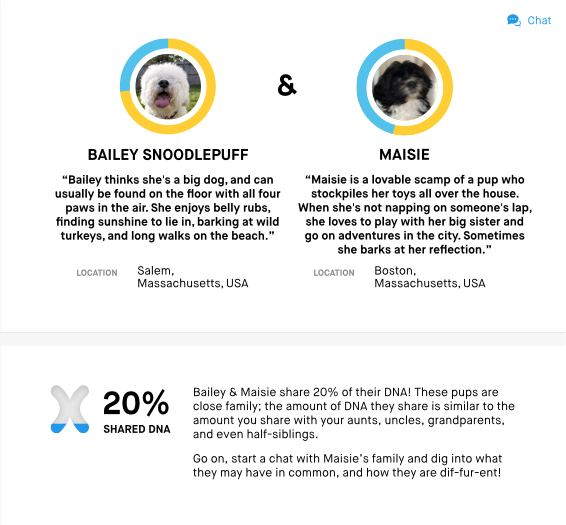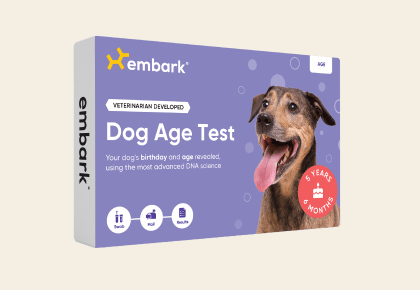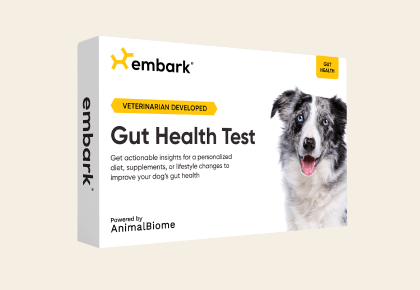Embark offers the world’s first canine relative finder, so you can further explore your dog’s DNA story. Our Relative Finder shows your dog’s relatives based on how much DNA they share, and can identify parent or sibling relationships. It also gives you the ability to connect with their owners. In fact, it has already led to several family reunions, like Vardis and his long-lost sister Brunch and brothers Rowan and Milo!
Read on to learn how to use the Relative Finder to find your dog’s DNA relatives.
How does Embark find my dog’s relatives?
Embark analyzes your dog’s genome to find sections of DNA that are shared between your dog and other dogs. Generally, the more DNA they share, the more closely related they are.
Why is it important to find my dog’s relatives?
Connecting with your dog’s relatives can be helpful for your dog’s health the same way a family history helps humans manage our health. When owners with related dogs share information about conditions they’ve observed in their dogs, it can help both of them be better informed and proactive about their dogs’ health.
There’s a lot we still don’t know about the genetic roots for some diseases. The more genetic information we can collect about the genes that dogs share, the more health discoveries we can make.
Where can I see my dog’s relatives?
In your dog’s Embark profile, click the Relatives tab to see all your dog’s genetic relatives, from most closely related to distantly related. We’ll update this page as we test more dogs and find new relatives. (Relative Finder is available for dogs tested with a Breed ID, Breed + Health, or Purebred Kit.)

The Relative Finder shows you how closely related your dog may be to other dogs, in human terms—“as related as” human cousins, for example. But just because two dogs are “as related as” human siblings doesn’t always mean that they are from the same litter. It turns out that estimating the actual relationships between two dogs from genetics alone is more difficult in dogs than it is in humans.
In general, we consider mixed-breed dogs who share about half their DNA “as related as” siblings or a parent/child pair. DNA matches less than 50% indicate extended family (although this is not always the case! Unrelated dogs can sometimes share DNA, too, if they have a similar breed mix).
For purebred dogs, things are a little different. All purebred dogs within a breed are closely related. By default, they share more DNA than mixed-breed dogs. If you have a purebred dog, you’ll likely see a long list of genetic relatives. That doesn’t mean all those dogs are siblings. It just means that they have a lot of DNA in common. If your purebred dog really does have a close relative, you’ll often see that that relative has a very high percentage of shared DNA (sometimes even 70–80%).
Do my dog’s relatives share DNA like human siblings?
Family ties can be a little more complicated in dogs than in humans.
Genetic relatedness is the fraction of two dogs’ genomes that descend from the same ancestor(s). You probably already know that you are 50% genetically identical to each of your biological parents. Your siblings are, on average, 50% identical to you. (We say “on average,” because sometimes DNA can be mixed up and rearranged before it is passed down in a process called recombination.) Going further out, you are about 25% related to your aunts, uncles, and grandparents, 12.5% related to your first cousins, 3.125% related to your second cousins, and so on.
So, if your dog is about 12.5% related to another dog, does that mean that they are first cousins? It’s not quite that simple.
Just because two dogs are “as related as” first cousins doesn’t mean that they have that exact relationship. This is particularly true for purebred dogs, where a limited number of founder individuals created the breed, fairly recently in time. Because of this history of inbreeding, all dogs in a breed may be as related as first cousins (or even more so in some breeds), not because they are actually first cousins, but because they are third or fourth cousins several times over. For example, the figure below shows a pedigree for two purebred dogs. These two dogs would have results that say they are “as related as” second cousins, but they are actually quadruple third cousins (they have 12 instead of 16 great-grandparents).
Because of the tremendous variation in the amount and duration of inbreeding in dog populations, it’s harder to predict the relationship between two related dogs than it is in humans.
How can you tell who my dog’s parents or siblings are?
Although more distant canine relationships can be a bit harder to predict in dogs than in humans, we recently made our Relative Finder even smarter! We’re now able to tell you the relationship between your dog and other dogs when it can be determined. We do this by looking at how much DNA is shared and the pattern of how that DNA is shared between two individuals. Every dog inherits two copies of each of their chromosomes, one from each parent.
In a parent-child relationship, the parent passes down half their DNA to their puppy. This creates a specific pattern where the two dogs share one copy of each chromosome across their entire genome. When we see this pattern, we then use birthdate to determine who the parent is and who the child is in the relationship.
We would also expect to see about 50% shared DNA in a typical sibling relationship, but this occurs in a different pattern. Instead of siblings sharing just one copy of each chromosome as they do with their parents, we see a similar relatedness value but that relatedness is distributed across chromosomes in a different, but predictable way.
These pattern differences help us distinguish between parent-child relationships and siblings, even though the total amount of shared DNA may be similar. The exact percentage of shared DNA isn’t always exactly 50% — variations can occur, especially in purebred dogs where historical inbreeding can increase the shared DNA percentage above 50%.
It’s important to understand two key points about siblings:
- Not all siblings will be littermates. This is because the same two parents can have multiple litters of puppies, sometimes years apart. It’s also not uncommon to see differences in breed percentages and looks between siblings; even though each sibling inherits 50% of their DNA from each of their parents, it won’t be the same 50%. You can read more about this phenomenon in this post!
- It is also possible for littermates not to be full siblings due to a phenomenon called superfecundation. Unlike humans, female dogs in heat release multiple eggs over several days (and can be fertile for up to 10 days!). If the female mates with multiple male dogs during this fertile period, sperm from these different males can each fertilize eggs, resulting in puppies with different fathers in the same litter. This means puppies in the same litter can actually be half-siblings rather than full siblings!
Crater and Zion are siblings with 63% shared DNA, but approximately as related as half-siblings with Denali, with whom they have 34% shared DNA.
Whether you’re curious about your rescue dog’s lineage, hoping to connect with your pup’s relatives, or simply interested in learning more about your dog’s genetic heritage, Embark’s Relative Finder offers a unique window into your four-legged friend’s DNA story. As our database grows, so do the chances of discovering new family connections. So keep checking back—your dog’s long-lost sibling or cousin might be just an Embark test away!

Mimi Padmabandu Contributor
Mimi Padmabandu is a scientific writer and Senior Content Strategy Manager at Embark Veterinary. She has written about science and DNA for leading genomics companies. She holds a bachelor's degree in Molecular, Cell, and Developmental Biology from UCLA and a master’s degree in Early Modern English Literature from King’s College London.
Read more about Mimi Padmabandu










